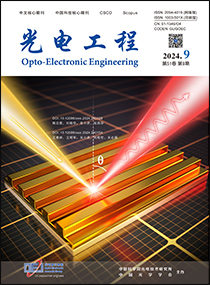2024 Vol. 51, No. 9
Cover story 1: Chen Z Y, Liu H T, Wu X H, et al. Progress in the research of directed thermal radiation[J]. Opto-Electron Eng, 2024, 51(9):240128
Thermal radiation is a fundamental physical process that refers to the spontaneous emission of electromagnetic energy from objects with temperatures above absolute zero due to the thermal motion of particles. Most thermal radiators lack directionality, resulting in energy loss in unnecessary directions, which reduces the efficiency of many thermal devices and applications. In practical applications, thermal radiators are usually required to exhibit different thermal radiation capabilities in different directions, therefore, controlling the directionality of the thermal emission is crucial in efficient heat transfer. The study of directional thermal radiation is of great significance in thermal imaging and sensing, radiative cooling, infrared encryption, and energy utilization. The review first describes the difference between traditional and directional thermal radiation, as well as the potential value of the latter at the frontiers of science. Subsequently, based on the characteristics of thermal radiation, it systematically organizes the research progress of domestic and foreign scholars in directional thermal radiation in terms of both narrowband directional thermal radiation and broadband directional thermal radiation. Finally, future research trends in this field are envisioned, and major challenges are analyzed, aiming to provide theoretical guidance and practical insights for the further development of directional thermal radiation technology.
Cover story 2: Wang Y T, Wang M J, Wu X H, et al. Review of research on nonreciprocal thermal radiation[J]. Opto-Electron Eng, 2024, 51(9): 240154
Nonreciprocal thermal radiation is a novel approach to radiative heat transfer that breaks through the symmetric reciprocity of traditional Kirchhoff's law. It overcomes the restriction that the spectrally oriented emissivity and spectrally oriented absorptivity of an object must be equal, allowing independent control of the spectral and angular emissivity and absorptivity of a radiator in both time and space. This paper reviews the progress of research on nonreciprocal thermal radiation in theoretical calculations, experimental verifications, and applications. Starting from the intrinsic connection between Kirchhoff's law and Lorentz reciprocity, it elaborates on the necessary conditions for the generation of nonreciprocal thermal radiation. Using two typical materials, magneto-optical materialsof InAs and Weyl semimetal, as examples, the paper explores how to construct asymmetric structures and utilize external field modulation to generate multi-wavelength and multi-angle nonreciprocal thermal radiation. These advancements have been applied in many fields, such as solar cells and thermophotovoltaic systems, successfully surpassing the blackbody limit of thermal radiation and theoretically reaching the Landsberg limit, thereby improving energy conversion efficiency. In the future, nonreciprocal thermal radiation is expected to provide strong support for efficient energy utilization and emission reduction, promote cutting-edge materials research and technological innovation, and inject new impetus and vitality into sustainable development.

-
{{article.year}}, {{article.volume}}({{article.issue}}): {{article.fpage | processPage:article.lpage:6}}. doi: {{article.doi}}{{article.articleStateNameEn}}, Published online {{article.preferredDate | date:'dd MMMM yyyy'}}, doi: {{article.doi}}{{article.articleStateNameEn}}, Accepted Date {{article.acceptedDate | date:'dd MMMM yyyy'}}CSTR: {{article.cstr}}
-
{{article.year}}, {{article.volume}}({{article.issue}}): {{article.fpage | processPage:article.lpage:6}}. doi: {{article.doi}}{{article.articleStateNameEn}}, Published online {{article.preferredDate | date:'dd MMMM yyyy'}}, doi: {{article.doi}}{{article.articleStateNameEn}}, Accepted Date {{article.acceptedDate | date:'dd MMMM yyyy'}}CSTR: {{article.cstr}}

 E-mail Alert
E-mail Alert RSS
RSS


